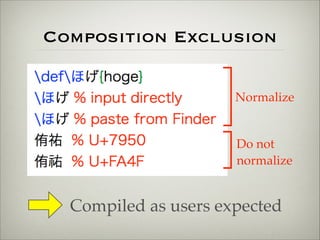

- #View full texshop history pdf#
- #View full texshop history code#
- #View full texshop history mac#
Bug fix: now, when the document is reloaded and you are using a non-continuous display style, the current page is not changed. Bug fix: now the page number, in the title bar, is displayed correctly when you are using "double pages, non continuous" display style. The main font used isURW-Garamond with mathdesign, while the sans font is TeX Gyre Adventor.The template used for the typesetting is tufte-book and the paper size is b5. A lot of help was derived from questions on. Bug fix: the zoom level is now saved again (was broken in 0.13.4). About the typesetting The typesetting was fun, and I am pleased with the results. When you manually change the zoom, in the toolbar's scale component, PDFView waits a second before updating the zoom level in the document, allowing you to type all the zoom level before changing it. You can keep now rotate the pages counterclockwise, by keeping Alt pressed when you use the shortcuts. The corresponding menu item to the selected display style is now checked. fault does appropriate rounding and decimal alignment and produces a file containing a LaTeX tabular environment to print the matrix or ame x as a table. latex is a generic function that calls one of fault, latex.function, latex.list. Other smaller improvements, and bug fixes: latex converts its argument to a ‘.tex ’ file appropriate for inclusion in a LaTeX2e document. Slightly changed the full screen behaviour: you can now use Exposé and Cmd+Tab when a document is displayed full screen. You can instruct PDFView to reopen automatically, at the next startup, documents that were displayed the last time you closed it. You can set up separated default width and height, for new windows. You can also use it in combination with the Shift, Command and Alt key for different zoom level. PDFView offers a new magnification tool (taken from TeXShop): you can hold your mouse button down and move it around to see the section of the document under the pointer magnified. Instructions about this can be found here.  PDFSync: you can set up your editor to open the file in PDFView, at a specific page. You can set up any text editor you like, and there's a preset for TextMate. When hold the Command key down, click on a point in the document to open the text editor on the corresponding line in the LaTeX source file. If you want a bold slanted Δ symbol for your bold slanted vector symbols in PDFTeX, I would recommend the isomath package.Version 0.14.0.1 Thursday, 14th December 2006 If you load amsmath, \boldsymbol\increment will work. You can acoomplish that with the following: \documentclass. You appear to want to use slanted capital Greek letters by default, including for the Δ symbol. Finally, there are the sans-serif math letters 𝞓 ( \mbfitsansDelta or \symbfsfup\Delta) and 𝝙 ( \mbfsansdelta or \symbfsfit\Delta) for tensors. \Delta might mean either the upright or slanted letter. after that and depending on your web browser, a window will pop up to open the file, save it to your Downloads folder or select a different location for the downloaded file.
PDFSync: you can set up your editor to open the file in PDFView, at a specific page. You can set up any text editor you like, and there's a preset for TextMate. When hold the Command key down, click on a point in the document to open the text editor on the corresponding line in the LaTeX source file. If you want a bold slanted Δ symbol for your bold slanted vector symbols in PDFTeX, I would recommend the isomath package.Version 0.14.0.1 Thursday, 14th December 2006 If you load amsmath, \boldsymbol\increment will work. You can acoomplish that with the following: \documentclass. You appear to want to use slanted capital Greek letters by default, including for the Δ symbol. Finally, there are the sans-serif math letters 𝞓 ( \mbfitsansDelta or \symbfsfup\Delta) and 𝝙 ( \mbfsansdelta or \symbfsfit\Delta) for tensors. \Delta might mean either the upright or slanted letter. after that and depending on your web browser, a window will pop up to open the file, save it to your Downloads folder or select a different location for the downloaded file. #View full texshop history pdf#
then in the download area click the PDF icon. There are also the letters Δ ( \mupDelta or \symup\Delta), 𝛥 ( \mitDelta or \symit\Delta), 𝚫 ( \mbfDelta or \symbfup\Delta) and 𝜟 ( \mbfitDelta or \symbfit\Delta). To download your final PDF file, in the editor click the Menu icon in the upper left corner. It provides △ as either the binary operator \bigtriangleup or the letter-like symbol \triangle, and ▵ as \vartriangle.

#View full texshop history mac#
This is semantically a math operator instead of a Greek letter. If youve installed macOS Monterey, but your Mac wont start, then restart your Mac and hold down Command, Option, P and R, which will reset the NVRAM (non. At the regular font size some figures will be difficult to read.
#View full texshop history code#
The Laplacian operator ∆ (U+2206) is \increment. It is recommended to make the code larger by adding Huge before the code (be careful its case sensitive). There are several such symbols in Unicode, and hence unicode-math.







 0 kommentar(er)
0 kommentar(er)
